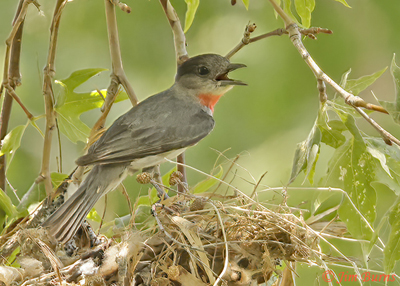
My son is not a birder, per se, but he knows I am, and he’s aware of the fantastic high the discovery of a rare bird brings to birders. Early in 2020 when scheduling a Covid vaccine shot was an internet nightmare, he told me he knew someone who could get me vaxxed. It was going to be my belated Christmas gift! Turns out there was a small lab in the foothills of the Sierra Madres in Mexico doing work on animal viruses. It’s actually not far from the cave where that vat of Corona Beer was accidentally contaminated with bat guano which started this whole thing.
So, after the courier from Chihuahua delivered the vax, my daughter-in-law, a trained med tech, came and gave me the jab. Side effects were nil. Oh, my arm was a little sore for a week or so, but as soon as the big circle of pinkish-orange skin on my bicep faded away, it was all good. The really cool thing was, that discoloration on my arm was a perfect match for the thick, exotic looking liquid in the vax vial.
Most folks have never really stopped to think about how the noun fantasy and the adjective fantastic are derived from the same root word. I’m here to tell you, though, beginning shortly after I got the jab, my birding world took a fantastic, and colorful, turn. I’m sure you recall my column about the Rufous-backed Robin that inexplicably spent almost a month last February visiting our yard off and on again for water and Russian Olives. You talk about a fantasy yard bird for an avid birder!
Then it wasn’t too long until the Roseate Spoonbill returned to the Gilbert Water Ranch after a hiatus of several weeks. One day, as I hopefully waited to photograph Rosie for the first time, she flew in and landed directly in front of me, wings fully opened but cupped in what I call “the conductor pose.” I had the camera up, the sun lined up behind me and the bird facing me full frontal, kind of a fantasy shot of arguably the most spectacular bird in North America, given its size. Someone watching mentioned the bird’s rosy color, pinkish-orange she called it, had gotten deeper and more extensive as it had aged in the months it had been around.
If there’s a harder bird in North America to photograph well than the Rose-throated Becard, I haven’t seen it. For starters, becards often go years in between their appearance north of the border. Then too, despite their spectacular, football shaped, oval hanging nest, the bird itself is small, inconspicuous except for that little splash of throat color, and vocalizes with thin, high whistles and twitters easily lost in the noise of the riparian streams they favor. You know where I’m going with this, right?
In June, laying on the ground to see through the viewfinder of my camera with my longest lens pointing up through the only small opening where the nest could be spotted through the thick spring foliage, I snapped a few frames of a male Rose-throated Becard calling atop its partially completed masterpiece nest, a different kind of artisanal construction. My Phoenix son would have been impressed.
My son is an avid reader, but he’s not a fan of my columns. He thinks I use big words and technical terms meant only for a birding audience. He says my work is too serious and that I should lighten up and write more imaginatively. I think I might try that one of the days. After all, birding can be fantastic, and birders all have fantasy sightings.
Meanwhile, my son also tells me he has an idea for my Christmas gift this year. He reports the virus lab in Mexico, Alternafax (or did he say Alternavax?), has hired a rogue ornithological epidemiologist (there I go again) who is working on a vaccine for birds which could actually alter their DNA to help them better withstand the changing climate. Can you imagine such a thing, altering a species’ DNA with a vaccine!? And, after this past year, I can’t wait to find out what this might have to do with my Christmas gift?
By the way, did you hear about the American Woodcock in the Chiricahuas? Hmmm?